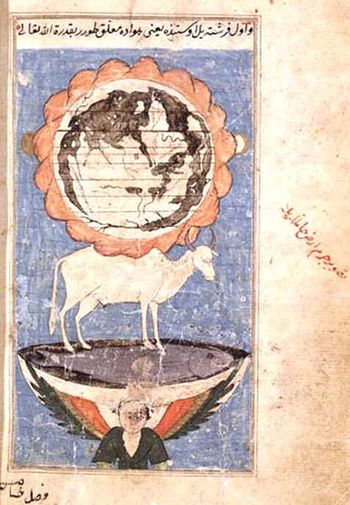「カフ山」の版間の差分
| (同じ利用者による、間の47版が非表示) | |||
| 1行目: | 1行目: | ||
| − | '''カフ山'''(Mount Qaf)、または'''カフ・ク'''(Qaf-KuhあるいはCafcuhあるいはKafkuh、ペルシア語: قافکوه)、または'''ジャバル・カフ'''(Jabal QafあるいはDjebel Qaf、アラビア語: Djebel Qaf)、または'''コ・イ・カフ'''(Koh-i-QafあるいはKoh-QafあるいはKuh-i-QafあるいはKuh-e Qaf、ペルシア語: Koh-Qaf)、またはク・イ・カフ(ペルシア語: Kuh-e-Qaf)。جبل قاف)、またはKoh-i-Qaf、Kuh-i-QafまたはKuh-e Qaf( Persian: کوہ قاف)は、中東の俗信にある伝説上の山である。イスラム教の伝統では、カフ山はジンの故郷であり、神によって輝くエメラルドで作られたと言われている<ref name="Lebling" | + | [[File:Islamic cosmology.jpg|thumb|350px|宇宙論 ザカリーヤ・アル・カズウィーニー<ref>1203-1283。ペルシア人の法学者、宇宙構造論学者、地理学者。</ref>著『被造物の驚異と万物の珍奇』に描かれたイラスト。このように宇宙の構造を視覚化することは、13世紀には珍しいことではなかった<ref name="Lebling">https://books.google.com/books?id=qKL3AgAAQBAJ , Legends of the Fire Spirits: Jinn and Genies from Arabia to Zanzibar, Lebling, Robert, I.B.Tauris, isbn:9780857730633, pages24-28</ref>。世界を背負う牛はクジャータ、魚はバハムート、その下の人物はジンを表す。いわゆる「世界樹」と同様の概念である<ref>「世界樹」の示す序列的な構造は「[[序列殺人]]」の図を参照のこと。</ref>。]] |
| + | '''Mount Qaf''', or '''Qaf-Kuh''', also spelled '''Cafcuh''' and '''Kafkuh''' ({{lang-fa|قافکوه}}), or '''Jabal Qaf''', also spelled '''Djebel Qaf''' (アラビア語:جبل ق | ||
| + | '''カフ山'''(Mount Qaf)、または'''カフ・ク'''(Qaf-KuhあるいはCafcuhあるいはKafkuh、ペルシア語: قافکوه)、または'''ジャバル・カフ'''(Jabal QafあるいはDjebel Qaf、アラビア語: Djebel Qaf)、または'''コ・イ・カフ'''(Koh-i-QafあるいはKoh-QafあるいはKuh-i-QafあるいはKuh-e Qaf、ペルシア語: Koh-Qaf)、またはク・イ・カフ(ペルシア語: Kuh-e-Qaf)。جبل قاف)、またはKoh-i-Qaf、Kuh-i-QafまたはKuh-e Qaf( Persian: کوہ قاف)は、中東の俗信にある伝説上の山である。イスラム教の伝統では、カフ山はジンの故郷であり、神によって輝くエメラルドで作られたと言われている<ref name="Lebling"/>。 | ||
== イランの伝承 == | == イランの伝承 == | ||
| − | + | 歴史上、イランの勢力は北コーカサス全域に及ぶことはなく、古代の言い伝えではこの高山は謎に包まれていた<ref>[http://www.naghashi.blogfa.com/post-43.aspx كوه قاف در اسطوره و عرفان ايراني] , https://web.archive.org/web/20090219041846/http://naghashi.blogfa.com/post-43.aspx , 2009-02-19</ref>。イランの伝承では、カフ山は以下のような特徴を持っていた。 | |
| − | + | * 高山である。 | |
| − | * | + | * ''ガプク''(Gapkuh)と呼ばれる「未知」の山である<ref>''カフ''(Qāf)は、中世ペルシャ語で「不明」を意味する「gâp」がアラビア語化したものである。''ガプク''(Gapkuh)または''未知の山''についての最古の記述は、シャプール1世(AD241-272)の黒海とカスピ海の間の山々についての碑文である。コーカサス山脈の名前は、最終的に''ガプク''(Gapkuh)の変種である''Kapkof''または''Kafkaz''から来ていると言われている。</ref>。 |
| − | * | + | * ダエーワ(ゾロアスター教を信仰しなかった人)の国 |
| − | * | + | * サオシュヤントの戦場 |
| − | * | + | * [[シームルグ]]の巣 |
| − | * [[ | + | カフ山の[[ペリ]]の王国と[[ディヴ]]の王国には、壮大な首都ユヘラバード(Juherabad)(宝石都市)を持つShad-u-kam(快楽と喜び)、アンバーラバード(Amberabad)(琥珀都市)、アヘルマナーバード(Ahermanabad)が含まれる<ref name="Lebling"/>。 |
| − | |||
| − | |||
== アラビアの伝承 == | == アラビアの伝承 == | ||
| − | + | アラビア語で「カフ山」は、地球を取り囲む海の彼方にあることから「地の果て」と呼ばれる神秘的な山である<ref name="Qaf">[http://www.mythologydictionary.com/mount-qaf-mythology.html Mount Qaf - Mythology Dictionary](リンク切れ:22-05-09)</ref>。その遠さから、北極点はこの山と同じ、とされることもある<ref>Ibrahim Muhawi & Sharif Kanaana. ''Speak, Bird, Speak Again: Palestinian Arab Folktales.'' Berkeley University of California Press</ref><ref>Irgam Yigfagna; ''al-Jabal al-Lamma''</ref>。ハティム・タイの記述によると、カフ山は緑色のエメラルドやペリドット、クリソライトで構成され、その反射で空が緑色に染まっている、と言われている。カフ山はジン族の故郷であり、その先には目に見えない神の世界が始まるとされている。アラビアでは、カフ山はアッラーが地球を支えるために創った山脈の中で最も高く、他のすべての地上の山脈の親であり、その山脈は地下でつながっているとされる。この山脈は、既知の世界を取り囲む海によって、人間の世界と隔てられている。カフ山は原始の山として、自然と超自然が出会う宇宙の山を象徴するようになり、地上と天上の世界のつながりともみなされたのである。ここには、[[アンカ]]と[[ロック鳥]]が来ると言われている。暗闇の中にあるエメラルドでできた都市ジャブルカとジャブルサは、カフ山に隣接していると言われている<ref name="Lebling"/><ref name="Qaf"/><ref name="wonders">Qazwīnī Zakarīyā Ibn-Muḥammad al- , Kosmographie: ¬Die Wunder der Schöpfung , 1849 , Dieterich , https://books.google.com/books?id=eCk-AAAAcAAJ&pg=PT152 , 3 October 2019</ref>。 | |
| − | |||
| − | |||
| − | |||
| − | |||
| − | |||
| − | |||
| − | + | ザカリーヤ・アル・カズウィーニーは13世紀に『被造物の驚異と万物の珍奇』を出版し<ref>[https://www.wdl.org/en/item/15264/ The Wonders of Creation - World Digital Library]</ref>、近世のイスラーム社会に大きな影響を及ぼした。カズウィーニーの宇宙論によれば、空は地球に落ちないように神によって保たれている。地球は平らで(後のイスラム学者たちは地球は丸いと考えていた)、カフ山を含む一連の山々に囲まれており、地球を釘のように固定している。地球は、宇宙の海に住む巨大魚バハムート(بهموت , ''Bahamūt'')に立つクジャタ<ref>中世のイスラームの宇宙観により伝承される世界牛</ref>によって支えられ、海は天使やジンの上に乗っている鉢の中に入っている<ref>Zakariya al-Qazwini. ''ʿAjā'ib al-makhlūqāt wa gharā'ib al-mawjūdāt'' (The Wonders of Creation). Original published in 1553 AD</ref>。 | |
| − | |||
| − | + | ある著者によれば、イスラム教の宇宙論におけるジャバル・カフは、ルペス・ニグラが変化したもので、ダンテの煉獄の山登りのように、巡礼者が精神状態を変化させていくことを表す山であるという<ref>Irgam Yigfagna; ''al-Jabal al-Lamma'', p. 44</ref>。 | |
| + | == スーフィズムの伝承 == | ||
| + | アブドゥル・ラフマーンやファリードゥッディーン・アッタールが考えたようなスーフィズムの口伝では、カフ山は意識の領域であり、''ムリード''<ref>ムリード(アラビア語のمُرِيد「求める者」)は、精神的指導者のもとでスルーク(道を渡ること)することによって精神的悟りを得ようとする初心者のこと。サーリクやスーフィーの信奉者は、ムルシッドに誓約(bay+ah)して初めてムリードとなる。ペルシャ語ではshāgirdと呼ばれる。</ref>の目標であると考えられていた。ハダ・サーヒブ(1903年没)は、一晩でカフ山を訪れ、ペリの王に迎えられたと言われている<ref>PRIOR, DANIEL G. “TRAVELS OF MOUNT QĀF: FROM LEGEND TO 42° 0' N 79° 51' E.” Oriente Moderno, vol. 89, no. 2, 2009, pp. 425–444. JSTOR, www.jstor.org/stable/25818227. Accessed 18 Mar. 2020.</ref>。 | ||
| − | '' | + | == 文献 == |
| + | ''カフ山''(原題:Kafdağı)は、トルコの作家Müge İplikçiの小説の題名でもある。 | ||
| − | + | カフ山は、『千一夜物語』の中でジンが住んでいる場所として頻繁に登場する。 | |
== 関連項目 == | == 関連項目 == | ||
| − | *[[ロック鳥]] | + | * [[ロック鳥]] |
| + | * [[序列殺人]] | ||
| − | == | + | == 詳細な資料 == |
* Daniel G. Prior: ''Travels of Mount Qāf: From Legend to 42° 0' N 79° 51' E.'' in: ''Oriente Moderno, Nuova serie, Anno 89, Nr. 2.'' (Studies on Islamic Legends) 2009, pp. 425–444 | * Daniel G. Prior: ''Travels of Mount Qāf: From Legend to 42° 0' N 79° 51' E.'' in: ''Oriente Moderno, Nuova serie, Anno 89, Nr. 2.'' (Studies on Islamic Legends) 2009, pp. 425–444 | ||
== 参考文献 == | == 参考文献 == | ||
| − | * Wikipedia:[https://en.wikipedia.org/wiki/Mount_Qaf Mount Qaf] | + | * Wikipedia:[https://en.wikipedia.org/wiki/Mount_Qaf Mount Qaf](最終閲覧日:22-05-13) |
== 参照 == | == 参照 == | ||
{{DEFAULTSORT:かふさん}} | {{DEFAULTSORT:かふさん}} | ||
| + | [[Category:イラン神話]] | ||
[[Category:中東]] | [[Category:中東]] | ||
| − | [[Category: | + | [[Category:霊山]] |
2022年5月13日 (金) 19:09時点における最新版
Mount Qaf, or Qaf-Kuh, also spelled Cafcuh and Kafkuh (テンプレート:Lang-fa), or Jabal Qaf, also spelled Djebel Qaf (アラビア語:جبل ق カフ山(Mount Qaf)、またはカフ・ク(Qaf-KuhあるいはCafcuhあるいはKafkuh、ペルシア語: قافکوه)、またはジャバル・カフ(Jabal QafあるいはDjebel Qaf、アラビア語: Djebel Qaf)、またはコ・イ・カフ(Koh-i-QafあるいはKoh-QafあるいはKuh-i-QafあるいはKuh-e Qaf、ペルシア語: Koh-Qaf)、またはク・イ・カフ(ペルシア語: Kuh-e-Qaf)。جبل قاف)、またはKoh-i-Qaf、Kuh-i-QafまたはKuh-e Qaf( Persian: کوہ قاف)は、中東の俗信にある伝説上の山である。イスラム教の伝統では、カフ山はジンの故郷であり、神によって輝くエメラルドで作られたと言われている[2]。
イランの伝承[編集]
歴史上、イランの勢力は北コーカサス全域に及ぶことはなく、古代の言い伝えではこの高山は謎に包まれていた[4]。イランの伝承では、カフ山は以下のような特徴を持っていた。
カフ山のペリの王国とディヴの王国には、壮大な首都ユヘラバード(Juherabad)(宝石都市)を持つShad-u-kam(快楽と喜び)、アンバーラバード(Amberabad)(琥珀都市)、アヘルマナーバード(Ahermanabad)が含まれる[2]。
アラビアの伝承[編集]
アラビア語で「カフ山」は、地球を取り囲む海の彼方にあることから「地の果て」と呼ばれる神秘的な山である[6]。その遠さから、北極点はこの山と同じ、とされることもある[7][8]。ハティム・タイの記述によると、カフ山は緑色のエメラルドやペリドット、クリソライトで構成され、その反射で空が緑色に染まっている、と言われている。カフ山はジン族の故郷であり、その先には目に見えない神の世界が始まるとされている。アラビアでは、カフ山はアッラーが地球を支えるために創った山脈の中で最も高く、他のすべての地上の山脈の親であり、その山脈は地下でつながっているとされる。この山脈は、既知の世界を取り囲む海によって、人間の世界と隔てられている。カフ山は原始の山として、自然と超自然が出会う宇宙の山を象徴するようになり、地上と天上の世界のつながりともみなされたのである。ここには、アンカとロック鳥が来ると言われている。暗闇の中にあるエメラルドでできた都市ジャブルカとジャブルサは、カフ山に隣接していると言われている[2][6][9]。
ザカリーヤ・アル・カズウィーニーは13世紀に『被造物の驚異と万物の珍奇』を出版し[10]、近世のイスラーム社会に大きな影響を及ぼした。カズウィーニーの宇宙論によれば、空は地球に落ちないように神によって保たれている。地球は平らで(後のイスラム学者たちは地球は丸いと考えていた)、カフ山を含む一連の山々に囲まれており、地球を釘のように固定している。地球は、宇宙の海に住む巨大魚バハムート(بهموت , Bahamūt)に立つクジャタ[11]によって支えられ、海は天使やジンの上に乗っている鉢の中に入っている[12]。
ある著者によれば、イスラム教の宇宙論におけるジャバル・カフは、ルペス・ニグラが変化したもので、ダンテの煉獄の山登りのように、巡礼者が精神状態を変化させていくことを表す山であるという[13]。
スーフィズムの伝承[編集]
アブドゥル・ラフマーンやファリードゥッディーン・アッタールが考えたようなスーフィズムの口伝では、カフ山は意識の領域であり、ムリード[14]の目標であると考えられていた。ハダ・サーヒブ(1903年没)は、一晩でカフ山を訪れ、ペリの王に迎えられたと言われている[15]。
文献[編集]
カフ山(原題:Kafdağı)は、トルコの作家Müge İplikçiの小説の題名でもある。
カフ山は、『千一夜物語』の中でジンが住んでいる場所として頻繁に登場する。
関連項目[編集]
詳細な資料[編集]
- Daniel G. Prior: Travels of Mount Qāf: From Legend to 42° 0' N 79° 51' E. in: Oriente Moderno, Nuova serie, Anno 89, Nr. 2. (Studies on Islamic Legends) 2009, pp. 425–444
参考文献[編集]
- Wikipedia:Mount Qaf(最終閲覧日:22-05-13)
参照[編集]
- ↑ 1203-1283。ペルシア人の法学者、宇宙構造論学者、地理学者。
- ↑ 2.0 2.1 2.2 2.3 https://books.google.com/books?id=qKL3AgAAQBAJ , Legends of the Fire Spirits: Jinn and Genies from Arabia to Zanzibar, Lebling, Robert, I.B.Tauris, isbn:9780857730633, pages24-28
- ↑ 「世界樹」の示す序列的な構造は「序列殺人」の図を参照のこと。
- ↑ كوه قاف در اسطوره و عرفان ايراني , https://web.archive.org/web/20090219041846/http://naghashi.blogfa.com/post-43.aspx , 2009-02-19
- ↑ カフ(Qāf)は、中世ペルシャ語で「不明」を意味する「gâp」がアラビア語化したものである。ガプク(Gapkuh)または未知の山についての最古の記述は、シャプール1世(AD241-272)の黒海とカスピ海の間の山々についての碑文である。コーカサス山脈の名前は、最終的にガプク(Gapkuh)の変種であるKapkofまたはKafkazから来ていると言われている。
- ↑ 6.0 6.1 Mount Qaf - Mythology Dictionary(リンク切れ:22-05-09)
- ↑ Ibrahim Muhawi & Sharif Kanaana. Speak, Bird, Speak Again: Palestinian Arab Folktales. Berkeley University of California Press
- ↑ Irgam Yigfagna; al-Jabal al-Lamma
- ↑ Qazwīnī Zakarīyā Ibn-Muḥammad al- , Kosmographie: ¬Die Wunder der Schöpfung , 1849 , Dieterich , https://books.google.com/books?id=eCk-AAAAcAAJ&pg=PT152 , 3 October 2019
- ↑ The Wonders of Creation - World Digital Library
- ↑ 中世のイスラームの宇宙観により伝承される世界牛
- ↑ Zakariya al-Qazwini. ʿAjā'ib al-makhlūqāt wa gharā'ib al-mawjūdāt (The Wonders of Creation). Original published in 1553 AD
- ↑ Irgam Yigfagna; al-Jabal al-Lamma, p. 44
- ↑ ムリード(アラビア語のمُرِيد「求める者」)は、精神的指導者のもとでスルーク(道を渡ること)することによって精神的悟りを得ようとする初心者のこと。サーリクやスーフィーの信奉者は、ムルシッドに誓約(bay+ah)して初めてムリードとなる。ペルシャ語ではshāgirdと呼ばれる。
- ↑ PRIOR, DANIEL G. “TRAVELS OF MOUNT QĀF: FROM LEGEND TO 42° 0' N 79° 51' E.” Oriente Moderno, vol. 89, no. 2, 2009, pp. 425–444. JSTOR, www.jstor.org/stable/25818227. Accessed 18 Mar. 2020.
